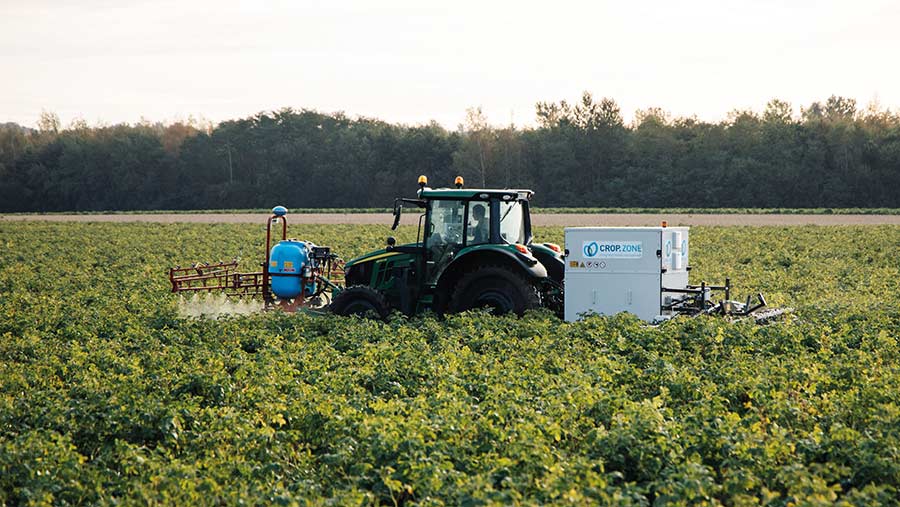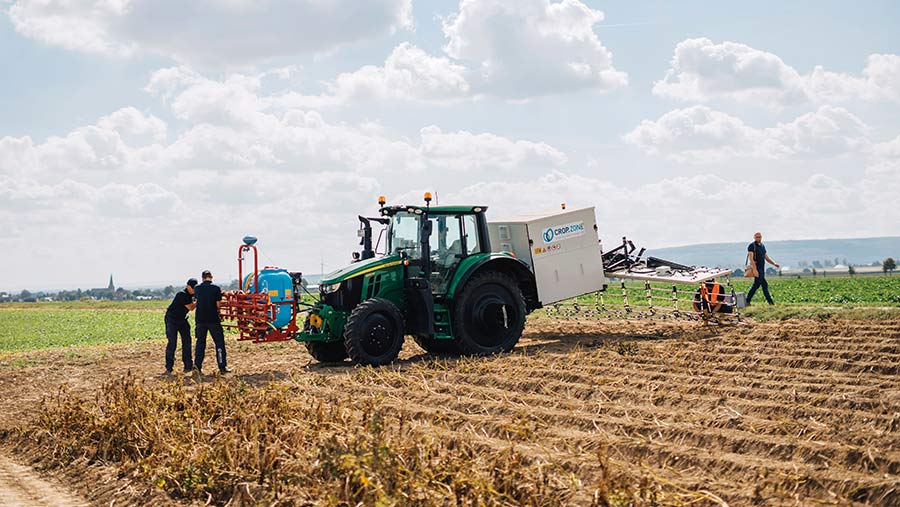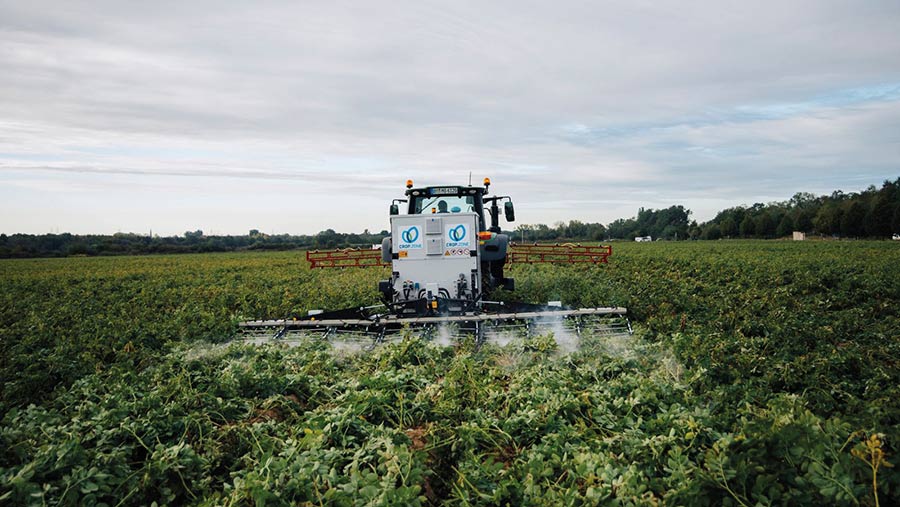New hybrid system aims to streamline electric weed control
 © Nufarm
© Nufarm A novel hybrid system that combines a specialist conductive spray solution and electric current is aiming to improve on the work rate and efficiency of existing electrical weed control designs.
The concept of electricity to kill plants has been around for a century, but in recent years it has attracted increasing interest in agriculture as conventional herbicides disappear at a rate of knots.
There is also a push to dramatically reduce the quantities of agrochemicals used in food production, enshrined in the new European Green Deal and the UK’s National Action Plan for the sustainable use of pesticides.
See also: Digital weed zapper offers alternative to chemical herbicides
Farmers Weekly first reported on the Xpower electronic weeder from German company Zasso in 2018, when the 3m machine had successfully completed trials and was set to be launched by CNH Industrial from 2019.
However, it had some key weaknesses. For effective destruction of potato haulm, the Xpower passes 7,000-10,000V through the target.
The need for such high current results in slow operating speeds and a limited ability to go wider to compensate.
Similarly, British company Rootwave has developed its own electronic weed killers, with a tractor-mounted option generating about 8,000-15,000V.
It also requires a constant earth contact during operation.
Nucrop electric weed control system – key points
- Conductive spray enhances weed kill while reducing power requirement
- Initial target market will be for potato haulm destruction
- Grass destruction, stale seed-bed creation and inter-row weeding to come later
- Will be demoed in Scottish seed spuds in 2021 (subject to Covid-19 restrictions)
- Experience in the Netherlands and Germany shows good haulm kill with no negative impact on tuber quality
Problems solved
A new collaboration between Aachen-based German start-up Cropzone and agrochemical manufacturer Nufarm believes it has addressed some of these concerns with its Nucrop digital weeding package.
Like the Zasso and Rootwave, it delivers electrical current to the target plants through amplifiers that make contact with the foliage during operation.
However, the use of a patented “Volt.fuel” solution formulated by Nufarm is where it differs from its competitors, with the liquid applied ahead of the amplifiers using a front linkage-mounted boom sprayer.
The conductivity-boosting spray – which is certified for use in organics – means that the very high voltage of its competitors is not needed, with Nucrop achieving an efficient kill by zapping just 1,000-1,500V through the plant foliage and roots.
Observers of the system have questioned if the same effect can be achieved with water alone, but as water diverts the current around the plant instead of through it, results are much worse.
Its creators believe the lower voltage gives more scope to scale up the size of the machine while still remaining relatively lightweight.
The current design is already at 12m and there is a realistic ambition to take it to 24m and beyond, making work rates much higher than the current 6-7ha/hour.
The 12m machine has a tractor power requirement of about 190hp – this will inevitably increase as working widths grow, but it is unclear by how much.

Nufarm plans to conduct UK trials this year using a 12m machine in a seed potato crop © Nufarm
Less mess
With the loss of diquat as a desiccant, most potato growers have shifted to a flail and spray method of haulm destruction.
Due to the size limitation of toppers, growers have to drive on fresh ground rather than down tramlines and, in a wet year, this makes both crop and soil damage a distinct possibility.
For producers in the North, particularly in crops grown for seed, bacterial disease infection can also be spread by flail use, so it is a method many are keen to move away from, given a viable alternative.
Iain Allan, Nufarm business development manager for Scotland, told Farmers Weekly that increasing the Nucrop’s working width to fit within tramlines will give it a huge advantage and make the technology very attractive.
There has already been considerable interest among potato growers of all kinds, but particularly from seed producers in the North, and this is where Nucrop’s initial marketing efforts will be focused.
Those wishing to see how the system fares in the UK can do so this season, with Nufarm aiming to bring a 12m machine over from Europe to conduct trials in seed crops in Angus.
Teaming up with a local contractor, it will look to prove the concept works in local conditions and fine tune recommendations on forward speed, treatment intervals and sequencing with agrochemicals and a flail topper.
The company will also have a presence with Nucrop at Potatoes in Practice in August and British Potato 2021 in November – provided trials and shows don’t get scuppered by the ongoing pandemic.
European experience
This year will hopefully provide a valuable insight into the system’s suitability for UK potato growers, but it has already undergone a solid two years of trials in mainland Europe.
Nufarm’s Netherlands-based technical adviser, Ronny Traas, says the Nucrop system has produced some very satisfactory results in range of potato varieties, including Fontane, Challenger, Innovator and Agria.
There are concerns associated with haulm destruction methods, such as vascular browning – which occurs when plant death happens too quickly – or viability of tubers if destined for use as seed.
Testing of tubers harvested from Nucrop trials has shown no vascular browning or adverse effect on cooking and processing quality. In seed, tubers still produced viable sprouts after all treatments.
With any desiccation system for potatoes, slow burndown increases the risk of late blight infection or virus transmission by aphids on lingering green material.

Haulm begins to wilt immediately after application © NuFarm
Mr Traas says that haulm begins to wilt immediately, and within seven to 10 days, it is evident that the haulm is dying off, putting it in a comparable “speed of kill” bracket as other available options.
Crop protection products such as blight fungicides can also be added to the Volt.fuel solution when passing through the crop, helping to protect against disease.
Worm-friendly
Any worries about the outfit’s impact on soil biology have been allayed, at least with regards to earthworms, after controlled field experiments (where worms were buried in netted bags before treatment) showed no harmful effects.
Along with the 2021 UK trials, further work will be carried out in mainland Europe too, exploring the implications of the system for disease development and virus transmission. This will help to improve recommendations.
Although potato desiccation is the primary focus when the concept is fully commercialised in 2022, the Nucrop collaboration is also hoping to develop other uses for the same weeding unit.
These will include adaptations for the destruction of grass leys, preparation of stale seed-beds in arable crops, inter-row weeding in crops such as sugar beet and maize, plus amenity use.
All of these spin-offs would help make any farmer or contractor investment more economically viable, particularly as glyphosate is phased out in countries such as Germany and France.
Initially, the Nucrop system is likely to be leased and users charged on an area basis, with the price said to be competitive with other haulm destruction techniques.
This will allow time for the company to improve the design and iron out any early problems that may arise, before inviting customers to buy their own unit outright.

